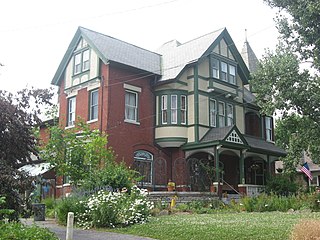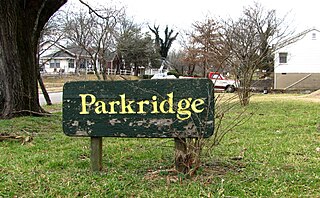
German Township is one of the fourteen townships of Auglaize County, Ohio, United States. The 2020 census found 3,751 people in the township.

George Franklin Barber was an American architect known for the house designs he marketed worldwide through mail-order catalogs. Barber was one of the most successful residential architects of the late Victorian period in the United States, and his plans were used for houses in all 50 U.S. states, and in nations as far away as Japan and the Philippines. Over four dozen Barber houses are individually listed on the National Register of Historic Places, and several dozen more are listed as part of historic districts.

The Peters House is a historic home located at 1319 Grainger Avenue in Knoxville, Tennessee. It is on the National Register of Historic Places. It is also known as White Columns or Columned Portals, as well as the George W. Peters House.

The Isaac Ziegler House was a historic home once located at 712 North 4th Avenue in Knoxville, Tennessee. Designed by prominent Knoxville catalog architect George Franklin Barber, it was listed on the National Register of Historic Places and was described as the most ornate Queen Anne-Romanesque house in Tennessee.

The George Scott House is a historic residence in Cincinnati, Ohio, United States. Built in the 1880s according to a design by prominent architect Samuel Hannaford, it was originally home to a prosperous businessman, and it has been named a historic site.

This is a list of the National Register of Historic Places listings in Ross County, Ohio.

This is a list of the National Register of Historic Places listings in Auglaize County, Ohio.

Little House is a historic house in Victoria, Texas, that was built circa 1896. It was listed on the National Register of Historic Places in 1986. It was deemed to be an "exceptional local example of a Victorian-era residence". Its Victorian features include asymmetrical massing and an octagonal turret on its second floor. It was listed on the National Register as part of a group of historic Victoria resources.

This is a list of the National Register of Historic Places listings in Preble County, Ohio.

St. Anthony's Catholic Church is a historic Roman Catholic church in Padua, an unincorporated community in Washington Township, Mercer County, Ohio, United States. Built in the late nineteenth century, it remains the home of a functioning congregation, and it has been recognized as a historically significant building because of its architecture.

Holy Rosary Catholic Church is a Roman Catholic parish on the east side of St. Marys, Ohio, United States. Established in 1852, the church has been recognized for its historic 1860s church building, which was demolished amid a period of growth in the 1970s and replaced with a modernist structure.

St. Sebastian's Catholic Church is a historic Roman Catholic church in Marion Township, Mercer County, Ohio, United States. Located in the unincorporated community of Sebastian, it is the home of an active congregation and has been declared a historic site because of its well-preserved early twentieth-century Gothic Revival architecture.

The Adolph Boesel House is a historic house in New Bremen, Ohio, United States. Built in 1898 in a combination of the Stick-Eastlake and Queen Anne styles of architecture, it was the home of a leading New Bremen citizen.

Fourth and Gill is a neighborhood in Knoxville, Tennessee, United States, located north of the city's downtown area. Initially developed in the late nineteenth century as a residential area for Knoxville's growing middle and professional classes, the neighborhood still contains most of its original Victorian-era houses, churches, and streetscapes. In 1985, 282 houses and other buildings in the neighborhood were added to the National Register of Historic Places as the Fourth and Gill Historic District.

Parkridge is a neighborhood in Knoxville, Tennessee, United States, located off Magnolia Avenue east of the city's downtown area. Developed as a streetcar suburb for Knoxville's professional class in the 1890s, the neighborhood was incorporated as the separate city of Park City in 1907, and annexed by Knoxville in 1917. In the early 1900s, the neighborhood provided housing for workers at the nearby Standard Knitting Mill factory.

The Colonel Joseph Barker House is a historic residence in Washington County, Ohio, United States. Located north of Marietta, in the Muskingum Township community of Devola, it has changed little since its construction in the early nineteenth century, and it has been designated a historic site.

BarberMcMurry, formerly Barber & McMurry, is an architecture firm based in Knoxville, Tennessee, USA. Founded in 1915 by Charles Irving Barber (1887–1962) and Benjamin Franklin McMurry, Sr. (1885–1969), the firm designed dozens of notable houses, churches, schools, and public facilities in Knoxville and the surrounding region in the early 20th century, several of which have been listed on the National Register of Historic Places. In recent decades, the firm has expanded its focus to include larger-scale projects, such as hospitals, stadiums and retail complexes.

The William Gedamke House is a historic residence in Gresham, Oregon, United States. Prominently located near Gresham's original business core, it is one of the finest expressions of the Queen Anne style in the city. It was constructed circa 1900, about the time the first interurban trains reached Gresham from Portland. The design was based on a widely circulated 1891 mail-order plan book by George F. Barber.





















